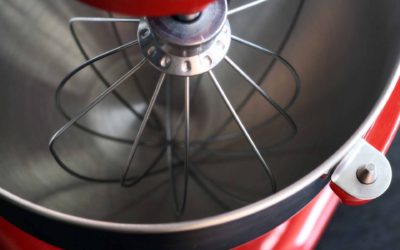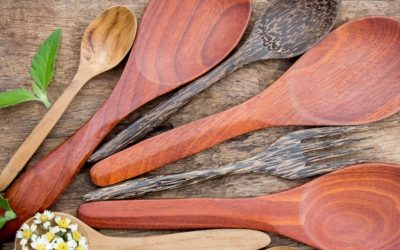Maintain Your Kitchen Equipment with a Honing Steel
January 1, 2018Every chef knows that a sharp blade is essential kitchen equipment.
Being able to slice through ingredients with ease means faster food prep, less strain on the hands and wrists, and a safer kitchen. When a knife is not honed, the extra pressure exerted on the knife, combined with the reduced control the user has over it, increases the chances of cutting fingers instead of food. This is why adding a honing steel to your kitchen equipment is just as important as having a good set of knives.
The honing steel, while being a handy piece of kitchen equipment, has a misleading alias. It is also called a sharpening steel. Contrary to what many believe, however, it doesn’t actually sharpen the blade. A honing steel is an essential kitchen equipment item that is made of a ridged rod of steel. As a blade is pulled across the rod, the ridges move the tiny dents and irregularities formed during regular knife use back into position. This way, the sharp, cutting edge of the blade is aligned for perfect action.
Knowing how to use this useful piece of kitchen equipment properly is as essential as owning one. So, without further ado, here are our tips for honing a knife.
- In one hand, hold the honing steel so that its steel tip is pointing down on a wood surface, such as a cutting board.
- With your other hand, hold the knife so that the part of the blade closest to the handle touches the honing steel at a 20-25 degree angle.
- Maintaining this angle, pull the blade gently upward and toward you. The whole length of the blade should graze the honing steel. Repeat about ten times on each side of the blade.
Knives should be honed daily to benefit both your kitchen staff and your restaurant’s budget. By removing imperfections in the edges of your knives on a regular basis, you can make them last longer. Therefore, your honing steel is an important piece of kitchen equipment that maintains the condition of your knives.
Proper knife maintenance doesn’t stop with your own kitchen equipment, though. Once every year, it is recommended that you send your knives to a professional for a true sharpening. Never mind extending the life of your kitchen equipment. The feeling of cutting through vegetables with a perfectly sharpened, perfectly honed knife is satisfaction enough!
5 Keys to Creating the Perfect Restaurant Seating Areas
Restaurants are about so much more than just food. From the setting and layout of your restaurant to your choice of colors, it takes a lot more than an appealing menu to keep diners coming back for more. When setting up your restaurant, booths and chairs are important...
5 Essential Buying Tips for Your Next Food Prep Work Table
The right foodservice equipment is pivotal to the efficiency of your kitchen. One of the most important types of foodservice equipment for any kitchen is the work table. With limited room on countertops available for your food prep needs, the cooking process can drag...
Tips for Keeping Your Commercial Sink Sparkling Clean
Your commercial kitchen, just like your personal kitchen, must be kept clean at all times. With all of the cooking and food processing you do, it is inevitable that your sink gets messy. Cleaning up your commercial kitchen is incomplete without proper cleaning of your...
Food-Cutting Secrets to Beautiful Dishes
In the restaurant industry, presentation is often said to be just as important as the food itself. Using the right knowledge, skills and restaurant supplies, you can incorporate creativity into your presentation, making guests feel that they are getting something...
Top Space-Saving Tips for Commercial Kitchens
Top Space-Saving Tips for Commercial Kitchens Space is always an important consideration when setting up a kitchen, and this is even truer for commercial kitchens. With a strong focus on functionality and the kitchen supplies that meet the needs of your commercial...
5 Ways to Get the Most Out of Your Mixer
No one wants to eat off of dirty or tarnished silverware. A stand mixer is a highly useful piece of kitchen equipment to invest in. Although this type of kitchen equipment does not usually come cheap, it can last a lifetime when properly cared for. Despite all your...
Restaurant Prep Tool Selection Simplified
What’s a restaurant kitchen without high-quality prep tools that can withstand the pressure of frequent use? Whether you already have a restaurant you’re running, or you’re just planning to launch one, one vital factor that could make or mar your business is how you...
Beginner’s Guide to Choosing a Commercial Ice Cream Freezer
Ice cream is a delicious and appealing desert treat for everyone, young or old. Having made the decision to sell ice cream to your customers, whether you have a restaurant, convenience store, or specialty ice cream parlor, it is time to begin stocking up on the right...
How to Choose the Right Kitchen Scales for Your Restaurant
A food scale is an essential item in every restaurant’s store of kitchen supplies. Designed to take the guesswork out of food measurement and maintain consistent food serving sizes, food scales are indispensable kitchen supplies in the commercial kitchen. With such a...
Beer Chilling Systems: Which Type Is Right for My Restaurant?
A refrigeration unit is integral to the functioning of any restaurant. Beers are best served cold - there’s no questioning that! But which beer chilling system is the best? From reach-in coolers to glycol chillers, a beer chilling system is an important piece of...
What Equipment Will I Need to run a Food Truck?
There’s a lot of planning that goes into starting your own food truck business. Before you hit the road with your delicious food offerings, you’ll need to fill up your truck with all the right foodservice equipment. Considering the lengthy list of possible items to be...
8 Types of Food Thermometers: What You Need To Know
Food thermometers are essential restaurant supplies for your commercial kitchen. They ensure that foods prepared in your commercial kitchen are cooked to the right temperature and held at that temperature for as long as necessary to kill any harmful bacteria. This...
How to Identify the Best Food Processor for Your Needs
Highly versatile and extremely efficient, food processors are designed to take away the hard work from repetitive kitchen activities. This type of cooking equipment can quickly become an invaluable tool in your kitchen. From chopping, to shredding, grinding, mincing,...
6 Keys to Choosing the Best Chafing Dishes for Your Restaurant
The chafing dish, also known as the chafer, is an essential piece of restaurant equipment for any establishment that wants to keep food hot. This type of restaurant equipment gets its name from the French word, chauffer, which means to heat, and it’s easy to see why....
Turning up the Dial on Commercial Fryers: How to Choose One for Your Restaurant
Fried food is a well-loved favorite. This is a fact. It also makes a fryer an important piece of equipment to have in your commercial kitchen. Just consider how many appetizers and sides require frying: onion rings, French fries, and fried green tomatoes are just a...















